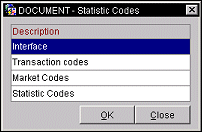
Back Office Translate Setup
Select Setup > System Configuration > External > Back Office > Translate. The Translate option allows you to translate OPERA system codes (Transaction Codes, Market Segment Codes or Daily Statistic Codes) to a code that can be understood by the external Back Office System. Translation Codes can also be used to group multiple Transaction (or Market Segment or Daily Statistics) codes under one particular Back Office System group code. These translation codes will be pre-defined by the external Back Office System. New translations can also be setup by the user.
Note: If a property has the OPP_PMS license active, OPP_S&C license active, OPP_BO add-on license inactive, OPP_EXP add-on license inactive, OPP_ESM add-on license inactive, OPP_COM add-on license active, Commission > Positive Pay Check Export application parameter is inactive, and Exports > Country Export application function is inactive, the Configuration menu option for External will no longer display without any menu options.

As required, select the check boxes for Transaction Codes, Market Codes, or Statistic Codes and then select OK.
Interface. Any information required at the Interface level can be defined in the Interface Translations. As an example, the Back Office specific property code, or the Back Office specific version number can be set up here in the interface translations and this code could be used in the export. The information set up here is not related to any Transaction code, Market Segment code or Statistic Code, and is only related to the property level interface.
Transaction Codes. Translations related to Transaction codes in OPERA can be defined here. The Translate setup lets you define the accounts and controls that will be used for assigning the account codes for a transaction code for the export.
Market Codes. Translations related to Market Segment codes in OPERA can be defined here.
Statistic Codes. Translations related to Daily Statistic Codes, like number of rooms, total occupancy etc. can be defined here.
The definition of these translation codes would be different for each Back Office system, and will be defined by the vendor. If translation codes are used by the vendor, then appropriate translations should be set up for the different codes (Transaction, Market Segments, Daily Statistics) before using the exports.
Translation and Configuration options in Back Office Setup are optional. There is not always a need to configure the Translation and Configuration sections if the export does not require additional translation for the Transaction, Market, or Daily Statistic codes. For an export to work, the minimum required is (1) a valid Interface Definition and (2) Layout Records defined as part of the interface setup, which is the Define Records option in the Back Office setup. You can have just one HDR/DTL/TTL record defined with valid columns from the valid tables defined for each type.
The required translation codes would be already set up for any of the standard interfaces. Select New to add a new translation code or Edit to change an existing translation code.
Data Type. Specify the data type (Character, Number, Date, Static).
Translation Code. Configure these codes according to the external system requirements. As part of the interface requirements, these codes will be used in the export setup (Define Records). These fields are user-definable and can be used to transfer additional informationthat the external system might need when importing the details.
Text. The text of the code, which describes the configured translation code, like Account Number, Department, or Tax.
Field Width. Enter the number of characters required for each of the defined fields.
See Also